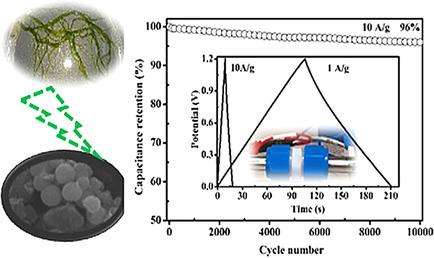当前位置:
X-MOL 学术
›
ChemElectroChem
›
论文详情
Our official English website, www.x-mol.net, welcomes your feedback! (Note: you will need to create a separate account there.)
High Performance N‐Doped Carbon Electrodes Obtained via Hydrothermal Carbonization of Macroalgae for Supercapacitor Applications
ChemElectroChem ( IF 4 ) Pub Date : 2018-07-02 , DOI: 10.1002/celc.201800603 Meng Ren 1 , Ziyang Jia 1 , Zhongwei Tian 1 , Diana Lopez 2 , Jinjun Cai 1, 3 , Maria‐Magdalena Titirici 3 , A. Belen Jorge 3
ChemElectroChem ( IF 4 ) Pub Date : 2018-07-02 , DOI: 10.1002/celc.201800603 Meng Ren 1 , Ziyang Jia 1 , Zhongwei Tian 1 , Diana Lopez 2 , Jinjun Cai 1, 3 , Maria‐Magdalena Titirici 3 , A. Belen Jorge 3
Affiliation

|
The conversion of bio‐waste into useful porous carbons constitutes a very attractive approach to contribute to the development of sustainable energy economy, even more as they can be used in energy storage devices. Here we report the synthesis of N‐doped carbons from hydrothermal carbonization of macroalgae, Enteromorpha prolifera (EP), followed by a mild KOH activation step. The obtained N‐doped carbons exhibited surface areas of up to ∼2000 m2/g with N‐loadings varied in the range of 1.4∼2.9 at %. By modifying activation temperature, we were able to tune the surface chemistry and porosity, achieving excellent control of their properties. The specific capacitance reached values of up to 200 F/g at 1 A/g in 6 M KOH for the sample obtained at activation temperature of 700 °C (AHC‐700). The symmetric supercapacitor using the sample activated at 800 °C (AHC‐800) as electrodes exhibited the highest cycling stability of the samples studied in this work, with capacitance retention of up to 96 % at 10 A/g, even after 10,000 cycles, constituting the highest reported for biomass‐derived carbon electrodes. These results show the great potential of N‐doped carbons as electrodes for supercapacitors and confirm the excellent electrochemical properties of biomass‐derived carbons in energy storage technologies.
中文翻译:

通过大型藻类的水热碳化获得的高性能N掺杂碳电极。
将生物废物转化为有用的多孔碳构成了一种非常有吸引力的方法,可以为可持续能源经济的发展做出贡献,甚至可以将其用于储能设备中。在这里,我们报告了通过大型藻类的热液碳化,Enteromorpha prolifera(EP)合成N掺杂碳,然后进行温和的KOH活化步骤。所获得的N掺杂碳的表面积高达〜2000 m 2 / g,N载量在1.4〜2.9 at%的范围内变化。通过改变活化温度,我们能够调节表面化学性质和孔隙率,从而实现对其性能的出色控制。对于活化温度为700°C(AHC-700)。使用在800°C(AHC- 800)下活化的样品作为电极的对称超级电容器表现出本研究中样品的最高循环稳定性,即使在10,000次循环后,在10 A / g时的电容保持率也高达96%,构成了由生物质衍生的碳电极的最高报告。这些结果表明,掺氮碳具有作为超级电容器电极的巨大潜力,并证实了储能技术中生物质衍生碳的优异电化学性能。
更新日期:2018-07-02
中文翻译:

通过大型藻类的水热碳化获得的高性能N掺杂碳电极。
将生物废物转化为有用的多孔碳构成了一种非常有吸引力的方法,可以为可持续能源经济的发展做出贡献,甚至可以将其用于储能设备中。在这里,我们报告了通过大型藻类的热液碳化,Enteromorpha prolifera(EP)合成N掺杂碳,然后进行温和的KOH活化步骤。所获得的N掺杂碳的表面积高达〜2000 m 2 / g,N载量在1.4〜2.9 at%的范围内变化。通过改变活化温度,我们能够调节表面化学性质和孔隙率,从而实现对其性能的出色控制。对于活化温度为700°C(AHC-700)。使用在800°C(AHC- 800)下活化的样品作为电极的对称超级电容器表现出本研究中样品的最高循环稳定性,即使在10,000次循环后,在10 A / g时的电容保持率也高达96%,构成了由生物质衍生的碳电极的最高报告。这些结果表明,掺氮碳具有作为超级电容器电极的巨大潜力,并证实了储能技术中生物质衍生碳的优异电化学性能。



























 京公网安备 11010802027423号
京公网安备 11010802027423号